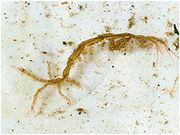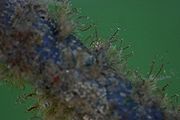Caprella laeviuscula
From ize2010
| Smooth Skeleton Shrimp | |
|---|---|
 |
|
| Caprellidae of unknown species | |
| Scientific classification | |
| Kingdom: | Animalia |
| Phylum: | Arthropoda |
| Class: | Malacostraca |
| Order: | Amphipoda |
| Family: | Caprellidae |
| Genus: | Caprella |
| Species: | C. laeviuscula |
| Binomial name | |
| Caprella laeviuscula Mayer, 1903 |
|
Despite their name as the Smooth Skeleton Shrimp, Caprella laeviuscula are not actually shrimp at all; they are amphipods. There are approximately 200 species of Caprellids, which are a suborder within the order of Amphipoda and phylum of Arthropoda. In addition to Caprella laeviuscula, several other Pacific Northwest species exist such as:
- Caprella ferrea
- Caprella Californica
- Caprella alaskana
- Caprella angusta
Contents |
Description
The average length for Caprella laeviuscula is about 3.5 cm [1]. The average length of the entire family of caprellidae is about 4 cm. The males tend to be much longer than the females.
Having very slender stick-like bodies, they resemble an inchworm while “walking”, a stick while sitting still and a praying mantis while catching prey. Their name describes them well since they resemble a skeleton posted upright, attached to the substrate they live within. Due to their blending ability, they are sometimes difficult to see. Like the Walking Stick insect, thier body shape and color help them blend perfectly into their surroundings and the gentle back and forth sway resembles substrate within the water current. They travel by extending forward, grasping with their gnathopods, inching upwards with their back (like an inchworm), bringing their pereopods forward to grasp and then repeating the process over. To swim, they rapidly bend and straighten their bodies.
Unlike a true shrimp within the order of decaoods, caprellids lack a carapace. Although the anatomy can differ slightly between species, their bodies are generally divided into three sections:
- Cephalon: head, gnathopod 1, antenna
- Thorax: gnathopod 2, branchiae (sac-like gills), brooding pouch (females), abdomen
- Pereopods: three appendages located at the posterior end of the thorax which are used for grasping
Habitat
Caprellids are exclusively marine and are found in oceans worldwide. A few species are found in the ocean depths but most prefer low intertidal zones and subtidal waters among eelgrass, hydroids and bryozoans. They are typically seen attached to substrate by their grasping appendages called the pereopods.
Diet
They are omnivores that feed upon diatoms, detritus, protozoans, smaller amphipods, and crustacean larvae. Some species will use their antenna to filter food from the water or scrape it off of the substrate and others will sit and wait like a praying mantis, with thier gnathopods ready to snatch any smaller invertebrates who come along.
Reproduction and Growth
Mating can only occur when the female is between the new and hardened exoskeletons, which both male and female do in order to grow. After mating the female will brood the fertilized eggs within her brood pouch. The young will hatch and emerged as juvenile adults [2]. After mating, the female in some species have been known to kill the males with a poison within their gnathopods [1].
Predators
Caprellids are typically preyed upon by surf perch, shrimp, nudibranchs such as the lion nudibranch (Melibe leonina) and brooding anenomes (Epiactis prolifera). Since they often inhabit eelgrass beds with sessile jellyfish, (Halicylystus and Thaumatoscyphus), the caprellids frequently become jellyfish food [3]. Caprellids are not normally considered a main source of food for fish, but when Shiner perch (Cymatogaster aggregata) migrate into the eelgrass beds for reproduction, caprellids suddenly become the targeted prey [4]
References
- ↑ 1.0 1.1 http://www.nwmarinelife.com/htmlswimmers/c_laeviuscula.html.
- ↑ http://www.racerocks.com/racerock/eco/taxalab/2005/caprellal/caprellal.htm.
- ↑ Kozloff, Eugene N. 1983. Seashore Life of the Northern Pacific Coast.
- ↑ Edsel A. Caine. 1991. Caprellid amphipods: fast food for the reproductively active. Journal of Experimental Marine Biology and Ecology. 148:27-33.
- Race Rocks http://www.racerocks.com/racerock/eco/taxalab/2005/caprellal/caprellal.htm
- NW Marine Life http://www.nwmarinelife.com/htmlswimmers/c_laeviuscula.html
- Shiner perch Edsel A. Caine. 1991. Caprellid amphipods: fast food for the reproductively active. Journal of Experimental Marine Biology and Ecology. 148:27-33.
- Sessile Jellyfish Kozloff, Eugene N. 1983. Seashore Life of the Northern Pacific Coast.

